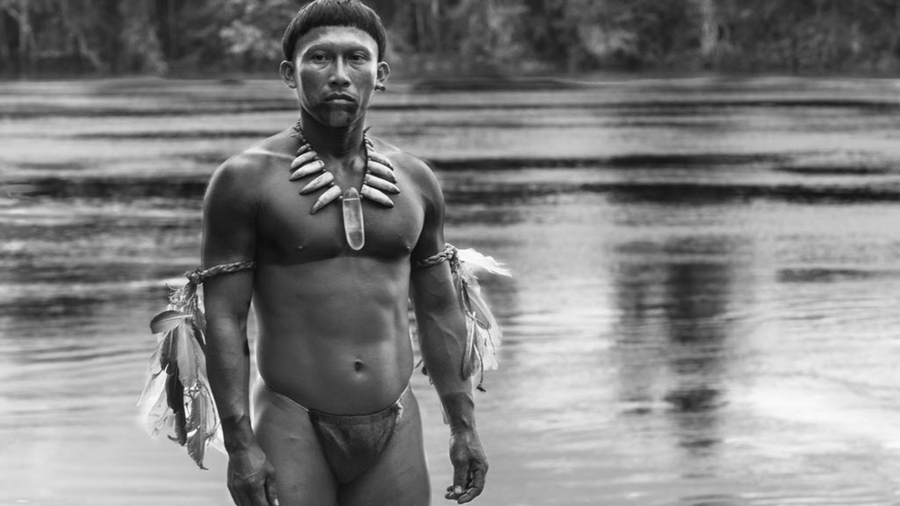'Embrace of the Serpent': Director Ciro Guerra's technique can be meditative but also just vaporous
Loading...
You can be sure that a journey upriver, at least in the movies, is never just a journey upriver. It’s a myth, an odyssey, a passage into the heart of darkness. From Werner Herzog’s “Aguirre, the Wrath of God” and “Fitzcarraldo” to Francis Ford Coppola’s “Apocalypse Now,” these trips run thick with doominess.
Now add to their number “Embrace of the Serpent,” the phantasmagoric third feature from Colombian director Ciro Guerra. (It’s a nominee for this year’s Oscar for best foreign language film.) Not nearly as great as Herzog’s films, or as monumentally deranged as Coppola’s, it nevertheless casts a spell of its own. It’s one of those films that, at least for me, grows in the memory.
Shot in lustrous, widescreen black and white, “Embrace of the Serpent” is, among other things, an elegy for the Colombian tribes decimated by colonialism, but it doesn’t have the punch of an indictment. Its artfulness is much stranger and nuanced. The film was inspired by the journals of two ethnographers who traveled the Amazon in the last century: in 1909, the German Theodor Koch-Grunberg (called Theo in the film and played by Jan Bijvoet) and, in the 1940s, the American Richard Evans Schultes (called Evan here and played by Brionne Davis).
Guerra constructs the story as a parallel journey, intercut and separated in time, involving the two men and a rainforest shaman, Karamakate (Nilbio Torres in 1909, Antonio Bolívar in the 1940s). In both eras, the explorers are searching for a sacred healing plant, the yakruna. Karamakate, whose tribe has been virtually eliminated by foreign invaders, initially offers no help to Theo, who is near death when he lands his canoe on the riverbank with his guide, Manduca (Yauenkü Miguee). Only after Theo offers to help the shaman locate other supposed survivors of his Cohiuano tribe does he relent. Karamakate’s healing powers, which appear to involve some kind of hallucinogen, revive Theo enough for him to carry on.
In the scenes involving Evan, Karamakate is now an old man who forlornly believes he can no longer communicate with nature – with rocks and trees and plants. As in the episodes with Theo, he is devastatingly alone in the jungle, but now his aloneness has a sharp sadness to it.
Since both Theo and Evan are on essentially the same quest, with Karamakate serving as guide, the parallelisms in the story are resonant. But Guerra frames the narrative mostly through the shaman’s eyes, or at least through his sensibility, so we never feel as if we’re being shown a movie about the ravages of colonialism through the eyes of colonialists. As such, the film takes some getting used to. The wayward sinuosity of Guerra’s free-floating technique can sometimes seem deeply mysterious and meditative, but sometimes it can just seem vaporous – more head trip than soul trip.
To his credit, though, Guerra doesn’t indulge in the sentimentalism that often attaches itself to quasi-ethnographic narratives of this stripe. (He cast his film using mostly members of the Cubeo and Wanano tribes.) He doesn’t portray the Amazon jungle as a pristine paradise despoiled by foreigners; rather, this is a world in which snake eats snake and no dividing line exists between prey and predator. But Guerra reserves a special ire for the rubber barons and Roman Catholic missionaries in the Theo sequences who invaded the forests. The film’s most devastating scenes involve their depredations.
In the Catholic mission scene, orphaned boys, victims of both the rubber barons and the infighting of indigenous tribes, are subject to horrific beatings by the Spanish priest who rules over them and forbids them to speak their “pagan” languages. (In all, nine languages are spoken in the film.) Later, in an Evan section, a riverside community is ruled over by a crazed white man who proclaims himself the Messiah.
Guerra’s saving grace is that, in this Amazonian realm, he also recognizes that white doesn’t automatically mean evil. This is brought out in a transcendent scene in which Evan, who has been encouraged by Karamakate to throw his possessions overboard, refuses to relinquish the portable record player on which he plays Handel’s “Creation.” Karamakate takes in the solemn, alien sounds with an appropriate regard. He recognizes that Handel is a kind of shaman, too. Grade: B+ (This film is not rated.)





